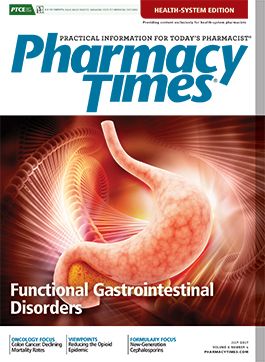Publication
Article
Pharmacy Practice in Focus: Health Systems
A Proactive Approach to Reducing the Prescription Opioid Epidemic in Your Community
Author(s):
A day does not go by without pharmacists, like most Americans, hearing about the overwhelming prescription opioid epidemic.
A day does not go by without pharmacists, like most Americans, hearing about the overwhelming prescription opioid epidemic. In the past, when patients or visitors asked hospital personnel how to dispose of their unused or expired drugs, the answer included flushing them or mixing them with coffee grounds and throwing them out. However, due to the passage of the Secure and Responsible Drug Disposal Act of 2010,1 implemented by the DEA’s Final Rule on Disposal of Controlled Substances released on September 9, 2014,2 there now are solutions that provide a safe way to prevent opioid diversion and are better for the environment.
Hospitals with onsite pharmacies are one of several types of health care institutions authorized by the DEA to collect controlled and noncontrolled drugs from consumers through onsite kiosks. However, due to the need to comply with the regulations, plan the logistics, and market the program to the community, hospitals have asked questions such as, “How do we comply with the DEA?” “Where does a hospital get a kiosk?” “How does it get emptied?” “How are the collected drugs transported and destroyed?”
The information below can assist with answering these and other questions, as well as outline the steps to implementing a drug collection program:
- The hospital must have an onsite pharmacy and modify its DEA registration to become an authorized collector, for which there is no fee.
- The hospital must select a DEA-registered reverse distributor that can provide the kiosk, inner liners for the drugs, transportation, schedule II storage, destruction, and documentation. Like medical waste disposal companies, the vendor is strictly regulated.
- The kiosk and inside container (or inner liner) must meet criteria defined by the DEA.
- The vendor must supply a Department of Transportation special permit to transport the material.
- The kiosk must have a locking door through which the drugs are dropped. It is recommended that the door providing access to remove the inner liner has 2 separately keyed safety locks. The goal is to add as much security as possible to prevent diversion.
- Signage on the receptacle will also help guide users as to which materials can and cannot be deposited into the kiosk, including “no sharps disposal.”
- The hospital must provide the vendor with a copy of their “Registrant-Collector” certificate.
- The hospital must secure the kiosk in a public area in view of hospital personnel, but not near the emergency department.
- When full, 2 authorized hospital employees open the kiosk, close the inner liner, and either store the container in a locked area or send it through a common carrier (eg, UPS) or authorized reverse distributor, as indicated by the vendor.
- Each step of placement, removal, storage, and transfer must be documented in a specific manner to comply with the DEA. The reverse distributor vendor can supply the proper forms.
The DEA’s Drug Disposal website is a comprehensive resource, providing easy access to register as a collector, FAQs, industry-specific factsheets, and a “wastage” letter clarifying the disposal of pharmaceutical wastage.3,4 The final rule does not change the way inventory controlled substances or drug wastage are accounted for and disposed; however, the DEA letter4 clarifies that practitioners shall continue to record the destruction of medication wastage in accordance with 21 CFR§1304.22(c). The letter emphasizes the following:
- A controlled substance that has been ordered and dispensed to a patient, but not fully administered, is considered wastage, not inventory, and should be disposed of per 21 CFR §1304.22(c), as well as all applicable federal, state, tribal, and local laws and regulations. No DEA Form 41 is required.
- In addition to inventory drugs, drug wastage may not be placed in a disposal kiosk.
Hospital pharmacists play a major role in educating hospital personnel, patients, and visitors on safe management of pharmaceuticals. Hospitals that provide a proper and compliant pharmaceutical collection and destruction program participate in the prevention of drug misuse, which has the potential to reduce hospital visits and deaths in the communities that they serve.
Jan Harris, MPH, BSDH, is director, Environmental, Health and Safety at Sharps Compliance, Inc.Robin Watson, MPH, MS, is director of Client Services at Sharps Compliance, Inc.Wanda Lingner, RN, BSN, is clinical specialist — Strategic Regulatory Customer Compliance at Sharps Compliance, Inc.
References
- One Hundred Eleventh Congress of the United States of America; S. 3397 [act]. DEA Diversion Control Division website. www.deadiversion.usdoj.gov/drug_disposal/non_registrant/s_3397.pdf. Published September 9, 2014. Accessed June 23, 2017.
- 21 CFR Parts 1300, 1301, 1304, et al. Disposal of controlled substances; final rule. DEA Diversion Control Division website. www.deadiversion.usdoj.gov/fed_regs/rules/2014/2014-20926.pdf. Published September 9, 2014. Accessed June 23, 2017.
- Drug disposal information. DEA website. www.deadiversion.usdoj.gov/drug_disposal. Accessed June 23, 2017.
- Rannazzisi JT. Dear practitioner letter. www.deadiversion.usdoj.gov/drug_disposal/dear_practitioner_pharm_waste_101714.pdf. Published October 17, 2014. Accessed June 23, 2017.







